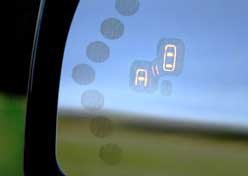enkeiavalanche
Full Member
- Joined
- Oct 23, 2002
- Messages
- 12,782
GM PUSHES FOR VEHICLE-TO-VEHICLE STANDARDIZATION
Vehicle-sensing technologies which could limit blind-spot collisions and deadly highway pileups have become a hot topic of discussion for automakers. In particular, General Motors Corp. ?is calling for industry-wide communications standards to ensure those systems proliferate.?
The Federal Communications Commission recently dedicated a 5.9-gigahertz frequency for vehicle systems which broadcast between one another. GM engineers recently demonstrated its vehicle-to-vehicle (V2V) technology. They say that industry collaboration ?is critical? if V2V applications are to be implemented into new vehicles. The Crash Avoidance Metric Partners (CAMP) consortium was established by General Motors and Ford to create some standardization for such systems. CAMP also includes DaimlerChrysler, Toyota Motor Corp., and Hyundai Motor Corp.
GM?s V2V system consists of a roof-mounted transponder, antenna, and communications chip. It will enable a vehicle to ?broadcast its location and monitor the positions of hundreds of other cars with the same capability 10 times every second?. The broadcast range is about 984 ft. which is about three times that of traditional radar. Reporters present for the demonstration were prompted to drive a Cadillac CTS at 35 mph directly into the path of a parked CTS without touching the brakes. As the approaching CTS drew closer to the parked car, a green vehicle icon on a dash-mounted monitor used to indicate the CTS? speed and the distance between vehicles turns to yellow. At about 30 yards out, the icon turns red and the parked vehicles turn signals and brake lights flash in a rapid warning sequence. A second later, the brakes seize control of the moving CTS and pull it to a stop 15 ft. short of the parked car.
The icon in this side mirror signals that a vehicle is in the left-side blind zone.
The V2V system is also able to alert a driver when a passing vehicle is approaching by flashing an amber caution light in the side mirror. If a driver engages a turn signal, and there is a vehicle in his or her blind spot, the system sends a vibration through the driver?s seat. The V2V system will determine whether or not to apply the brakes using algorithms that calculate the moving car?s speed and its time to impact. The same algorithm can trigger the taillights to flash, cautioning an approaching vehicle against tailgating, potentially preventing pileups or chain-reaction rear-end collisions on congested roads.
Although it may take 5 to 10 years before the technology is deployed widely, GM says that it may look into selling its V2V system as an aftermarket device, with a target price of $200.
Source: Scott Anderson, ?GM Pushing for V2V Standards?, WardsAuto.com.
Vehicle-sensing technologies which could limit blind-spot collisions and deadly highway pileups have become a hot topic of discussion for automakers. In particular, General Motors Corp. ?is calling for industry-wide communications standards to ensure those systems proliferate.?
The Federal Communications Commission recently dedicated a 5.9-gigahertz frequency for vehicle systems which broadcast between one another. GM engineers recently demonstrated its vehicle-to-vehicle (V2V) technology. They say that industry collaboration ?is critical? if V2V applications are to be implemented into new vehicles. The Crash Avoidance Metric Partners (CAMP) consortium was established by General Motors and Ford to create some standardization for such systems. CAMP also includes DaimlerChrysler, Toyota Motor Corp., and Hyundai Motor Corp.
GM?s V2V system consists of a roof-mounted transponder, antenna, and communications chip. It will enable a vehicle to ?broadcast its location and monitor the positions of hundreds of other cars with the same capability 10 times every second?. The broadcast range is about 984 ft. which is about three times that of traditional radar. Reporters present for the demonstration were prompted to drive a Cadillac CTS at 35 mph directly into the path of a parked CTS without touching the brakes. As the approaching CTS drew closer to the parked car, a green vehicle icon on a dash-mounted monitor used to indicate the CTS? speed and the distance between vehicles turns to yellow. At about 30 yards out, the icon turns red and the parked vehicles turn signals and brake lights flash in a rapid warning sequence. A second later, the brakes seize control of the moving CTS and pull it to a stop 15 ft. short of the parked car.
The icon in this side mirror signals that a vehicle is in the left-side blind zone.
The V2V system is also able to alert a driver when a passing vehicle is approaching by flashing an amber caution light in the side mirror. If a driver engages a turn signal, and there is a vehicle in his or her blind spot, the system sends a vibration through the driver?s seat. The V2V system will determine whether or not to apply the brakes using algorithms that calculate the moving car?s speed and its time to impact. The same algorithm can trigger the taillights to flash, cautioning an approaching vehicle against tailgating, potentially preventing pileups or chain-reaction rear-end collisions on congested roads.
Although it may take 5 to 10 years before the technology is deployed widely, GM says that it may look into selling its V2V system as an aftermarket device, with a target price of $200.
Source: Scott Anderson, ?GM Pushing for V2V Standards?, WardsAuto.com.




